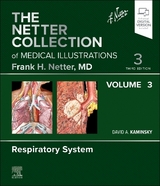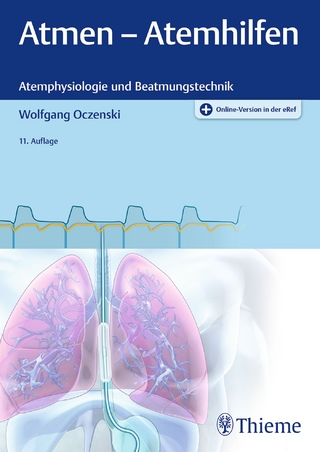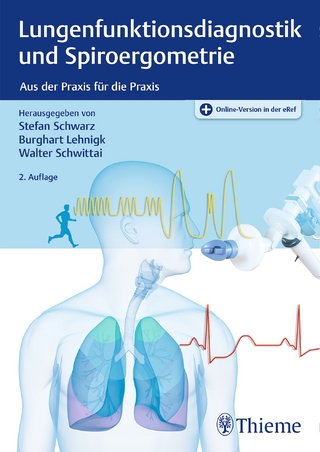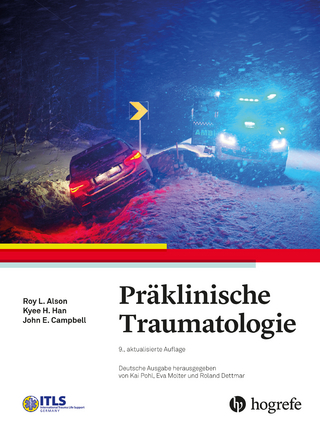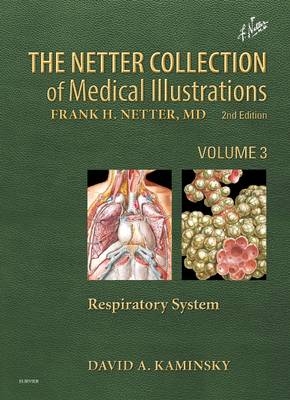
Netter Collection of Medical Illustrations: Respiratory System
Saunders (Verlag)
978-1-4377-0574-4 (ISBN)
Coming Soon - The long-awaited update of "The Netter Collection of Medical Illustrations" is now becoming a reality! Master artist-physician, Carlos Machado, and other top medical illustrators have teamed-up with medical experts to make the classic Netter 'green books' a reliable effective current-day reference. The first three volumes to be released will be: "The Reproductive System"; "The Endocrine System" and, "The Respiratory System".
Section 1 Anatomy and embryology * Respiratory System* Bony Thorax* Rib Characteristics and Costovertebral Articulations* Anterior Thoracic Wall* Anterior Thoracic Wall (Continued)* Anterior Thoracic Wall: Internal View* Dorsal Aspect of Thorax* Dorsal Aspect of Thorax: Posterior and Lateral Views* Course and Relations of Intercostal Nerves and Arteries* Diaphragm: Viewed from Above* Topography of Lungs: Anterior View* Topography of Lungs: Posterior View* Medial Surface of Lungs* Bronchopulmonary Segments* Bronchopulmonary Segments in Relationship to Ribs* Relations of Trachea and Main Bronchi * Bronchial Arteries * Mediastinum: Right Lateral View * Mediastinum: Left Lateral View * Innervation of Lungs and Tracheobronchial Tree * Structure of Trachea and Major Bronchi * Intrapulmonary Airways * Structure of Bronchi and Bronchioles - Light Microscopy * Ultrastructure of Tracheal, Bronchial, and Bronchiolar Epithelium * Bronchial Submucosal Glands * Intrapulmonary Blood Circulation * Fine Structure of Alveolar Capillary Unit: Ultrastructure of Pulmonary Alveoli and Capillaries* Fine Structure of Alveolar Capillary Unit (Continued): Type II Alveolar Cell and Surface-Active Layer* Fine Structure of Alveolar Capillary Unit (Continued): Pulmonary Vascular Endothelium * Lymphatic Drainage of the Lungs and Pleura * Lymphatic Drainage of the Lungs and Pleura: Distribution of Lymphatics * Pulmonary Immunology; Lymphocytes, Mast cells, Eosinophils, Neutrophils Development of Lower Respiratory System 1-33 Developing Respiratory Tract and Pharynx 1-34 Respiratory System at 5 to 6 Weeks 1-35 Respiratory System At 6 to 7 Weeks 1-36 Larynx, Traceobronchial Tree, and Lungs at 7 to 10 Weeks 1-37 Sagittal Section At 6 to 7 Weeks 1-38 Transverse Section At 5 to 8 Weeks 1-39 Diaphragm at 5 to 6 Weeks 1-40 Terminal Air Tube 1-41 Alveolar-Capillary Relationships At Age 8 Years 1-42 Surfactant Effects 1-43 Physiology of the Perinatal Pulmonary Circulation Section 2 physiology Pulmonary Mechanics and Gas Exchange 2-1 - 2-21 * Muscles of Respiration * Spirometry: Lung Volume and Measurement * Determination of Functional Residual Capacity (FRC) * Forces During Quiet Breathing * Measurement of Elastic Properties of Lung * Surface Forces In Lung * Elastic Properties of Respiratory System: Lung and Chest Wall * Distribution of Airway Resistance * Patterns of Airflow * Expiratory Flow * Forced Expiratory Vital Capacity Maneuver * Work of Breathing * Pleural Pressure Gradient and Closing Volume * Distribution of Pulmonary Blood Flow * Pulmonary Vascular Resistance * Pathways and Transfers of O2 and CO2 * Blood Gas Relationships During Normal Ventilation and Alveolar Hypoventilation * Ventilation - Perfusion Relationships * Shunts * Oxygen Transport * Role of Lungs and Kidneys in Regulation of Acid-Base Balance 2-22 Response to Oxidant Injury Lung Metabolism 2-23 Inactivation of Circulating Vasoactive Substances 2-24 Activation of Circulating Precursors of Vasoactive Substances Control and Disorders of Respiration 2-25 Chemical Control of Respiration (Feedback Mechanism) 2-26 Neural Control of Breathing 2-27 Respiraotry Response to Exercise 2-28 Effects of High Altitude on Respiraotry Mechanism 2-29 Hyperventilation and Hypoventilation 2-30 Periodic Breathing (Cheyne-Stokes) 2-31 Sites of Pathologic Disturbances in Control of Breathing Section 3 Diagnostic Procedures 3-1 - 3-3 Tests of Pulmonary Function Radiologic Examination of the Lungs 3-4 Normal Posterior-Anterior (PA) and Lateral Views of Chest 3-5 Lateral Decubitus View 3-6 Technique of Helical Computerized Tomography (CT) 3-7 Right Bronchial Tree as Revealed by Bronchograms 3-8 Left Bronchial Tree as Revealed by Bronchograms 3-9 Pulmonary Angiography 3-10 Images from a PET-CT Scanner 3-11 Patterns of Lobar Collapse: Right Lung (After Lubert and Krause) 3-12 Patterns of Lobar Collapse: Left Lung (After Lubert and Krause) 3-13 Aveolar Versus Interstitial Disease 3-14 Distribution of Pulmonary Nodules 3-15 Aveolar Disease 3-16 Radiograph Consolidation Patterns of Each Segment of Lungs (AP Views) 3-17 Solitary Pulmonary Nodule 3-18 Airway and Pleural Diseases 3-19 Abnormalities of the chest Wall and Mediastinum 3-20 Exhaled breath analysis Endoscopic Procedures 3-21 Flexible Bronchoscopy 3-22 Bronchoscopic Views 3-23 Nomenclature for Peripheral Bronchi 3-24 Rigid Bronchoscopy 3-25 Endobronchial Ultrasound 3-26 Mediastinotomy and Mediastinoscopy Section 4 Diseases and Pathology Congenital Lung Disease 4-1 Congenital Deformities of Thoracic Cage 4-2 Pathology of Kyphoscoliosis 4-3 Pulmonary Function in Kyphoscoliosis 4-4 Congenital Diaphragmatic Hernia 4-5 Tracheoesophageal Fistulas and Tracheal Anomalies 4-6 Pulmonary Agenesis, Aplasia and Hypoplasia 4-7 Congenital lung cysts 4-8 Pulmonary Sequestration 4-9 Congenital Lobar Emphysema 4-10 Chronic Cough Laryngeal Disorders 4-11 Common Laryngeal Lesions 4-12 Laryngeal Granuloma and Tracheal Stenosis 4-13 Vocal Cord Dysfunctions Bronchial Asthma 4-14 Allergic Asthma: Clinical Features 4-15 Non-Allergic Asthma: Clinical Features 4-16 Common Precipitating Factors in Etiology of Bronchial Asthma 4-17 Variable Airflow Obstruction and Airway Hyperresponsiveness 4-18 Sputum in Bronchial Asthma 4-19 Skin Testing for Allergy 4-20 Representative Differential Diagnosis of Bronchial Asthma 4-21 Blood Gas and pH Relationships 4-22 Airway Pathophysiology in Asthma 4-23 Mechanism of Type 1 (Immediate) Hypersensitivity 4-24 Pathology of Severe Asthma 4-25 General Management Principles for Allergic Asthma 4-26 Mechanism of Asthma Medications 4-27 Emergency Department Management of Asthma 4-28 Interrelationship of Chronic Bronchitis and Emphysema 4-29 Emphysema 4-30 Chronic Bronchitis 4-31 Mixed Chronic Bronchitis and Emphysema 4-32 Cor Pulmonale Due To COPD 4-33 Chronic Obstructive Pulomary Disease 4-34 Anatomic Distribution of Emphysema 4-35 Centriacinar (Centrilobular) Emphysema 4-36 Panacinar (Panlobular) Emphysema 4-37 COPD: Inflammation 4-38 COPD: Protease-Antiprotease Imbalances 4-39 Pulmonary Function in Obstructive Disease 4-40 Pathophysiology of Emphysema 4-41 High Resolution CT Scan of Lungs in COPD 4-42 Summary of COPD Treatment Guidelines Bronchiectasis 4-43 Bilateral Severe Bronchiectasis 4-44 Localized Bronchiectasis Cystic Fibrosis 4-45 Pathophysiology and Clinical Manifestations of Cystic Fibrosis 4-46 Radiographic and Gross Anatomical Findings of the Lung Cystic Fibrosis 4-47 Cystic Fibrosis: Clinical Aspects Lung Cancer Overview 4-48 Classification of Bronchogenic Carcinoma 4-49 Lung Cancer Staging 4-50 Squamous Cell Carcinoma of the Lung 4-51 Adenocarcinoma of the Lung 4-52 Large Cell Carcinomas of the Lung 4-53 Small Cell Carcinomas of the Lung 4-54 Superior Vena Cava Syndrome 4-55 Pancoast's Tumor and Syndrome Paraneoplastic Manifestations of Lung Cancer 4-56 Endocrine Manifestations of Lung Cancer 4-57 Neuromuscular and Connective Tissue Manifestations of Lung Cancer 4-58 Other Neoplasms of the Lung 4-59 Benign Tumors of Lung 4-60 Malignant Pleural Mesothelioma 4-61 Mediastinal Tumors: Anterior Mediastinum 4-62 Middle-Posterior and Paravertebral Mediastinum 4-63 Pulmonary Metastases Pneumonia 4-64 Overview of Pneumonia 4-65 Pneumococcal Pneumonia 4-66 Pneumococcal Pneumonia (Continued) Atypical Pathogen Pneumonia 4-67 Mycoplasmal Pneumonia 4-68 Chlamydophila Psittaci Pneumonia 4-69 Legionella Pneumonia 4-70 Staphylococcus Aureus Pneumonia 4-71 Hemophilus Influenzae Pneumonia 4-72 Gram -Negative Bacterial Pneumonia Viral Community-Acquired Pneumonia 4-73 Influenza Virus and its Epidemiology 4-74 Influenzal Pneumonia 4-75 Varicella Pneumonia 4-76 Cytomegalovirus Penumonia 4-77 Severe Acute Respiratory Syndrome (SARS) 4-78 Lung Abscess 4-79 Lung Abscess (Continued) 4-80 Overviews of HCAP, HAP and VAP 4-81 Overviews of HCAP, HAP and VAP (Continued) 4-82 Pneumonia in the Compromised Host 4-83 Pneumonia in the Compromised Host (Continued) 4-84 Actinomycosis 4-85 Nocardiosis 4-86 Histoplasmosis 4-87 Histoplasmosis (Continued) 4-88 Coccidioidomycosis 4-89 Blastomycosis 4-90 Paracoccidioidomycosis 4-91 Cryptococcosis (Torulosis) 4-92 Aspergillosis Tuberculosis 4-93 Dissemination of Tuberculosis 4-94 Evolution of Tubercle 4-95 Initial (Primary) Tuberculosis Complex 4-96 Progressive Pathology 4-97 Extensive Cavitary Disease 4-98 Miliary Tuberculosis 4-99 Tuberculin Testing 4-100 Sputum Examination 4-101 Sputum Culture 4-102 Nontuberculous Mycobacterial Lung Disease Lung Diseases Caused by the Inhalation of Particles and Fumes 4-103 Overview of Inhalation Diseases 4-104 Silicosis 4-105 Silicosis (Continued) 4-106 Coal Worker's Pneumoconiosis 4-107 Asbestosis and Asbestos-Related Diseases 4-108 Asbestosis and Asbestos-Related Diseases (Continued) 4-109 Beryllium 4-110 Pneumoconiosis Caused by Various Minerals and Mixed Dusts 4-111 Pneumoconiosis Caused by Various Minerals and Mixed Dusts (Continued) 4-112 Hypersensitivity Pneumonitis 4-113 Hypersensitivity Pneumonitis (Continued) Pulmonary Embolism/Venous Thromboembolism 4-114 Predisposing Factors for Pulmonary Embolism 4-115 Sources of Pulmonary Emboli 4-116 Clinical Manifestations of Leg Vein Thrombosis 4-117 Ultrasound and CT in Diagnosis of Acute Venous Thromboembolism 4-118 Embolism of Lesser Degree without Infarction 4-119 Pulmonary Infarction 4-120 Massive Embolization 4-121 Mechanical Defenses Against and Chronic Effects of Pulmonary Embolism 4-122 Special Situations and Extravascular Sources of Pulmonary Emboli Pulmonary Hypertension 4-123 WHO Classification System of Pulmonary Hypertension 4-124 Pathology of Pulmonary Hypertension 4-125 Diagnosis of Pulmonary Hypertension 4-126 Therapy for Pulmonary Hypertension Pulmonary Edema 4-127 Pulmonary Edema: Pathway of Normal Pulmonary Fluid Resorption 4-128 Pulmonary Edema: Some Etiologies, and Hypotheses of Mechanisms Pleural Effusion 4-129 Pathophysiology of Pleural Fluid Accumulation 4-130 Pleural Effusion in Heart Disease 4-131 Unexpandable Lung 4-132 Parapneumonic Effusion 4-133 Pleural Effusion in Malignancy 4-134 Chylothorax Thoracic Trauma 4-135 Rib and Sternal Injuries 4-136 Flail Chest and Pulmonary Contusion Pneumothorax 4-137 Tension Pneumothorax 4-138 Open (Sucking) Pneumothorax 4-139 Hemothorax 4-140 Pulmonary Laceration 4-141 Tracheobronchial Rupture 4-142 Traumatic Asphyxia 4-143 Diaphragmatic Injuries Respiratory Distress Syndrome 4-144 Respiratory Distress Syndrome 4-145 Respiratory Distress Sydnrome (Continued) 4-146 Acute Lung Injury Interstitial Lung Diseases 4-147 Idiopathic Interstitial Pneumonias 4-148 Idiopathic Interstitial Pneumonias (Continued) 4-149 Idiopathic Interstitial Pneumonias (Continued) 4-150 Cryoptogenic Organizing Pneumonia 4-151 Pulmonary Alveolar Proteinosis 4-152 Idiopathic Pulmonary Hemosiderosis 4-153 Lymphangioleiomyomatosis 4-154 Pulmonary Langerhans Cell Histiocytosis 4-155 Sarcoidosis 4-156 Sarcoidosis (Continued) 4-157 Rheumatoid Arthritis 4-158 Systemic Sclerosis (Scleroderma) 4-159 Systemic Lupus Erythematosus 4-160 Dermatomyositis and Polymyositis 4-161 Pulmonary Vasculitis 4-162 Eosinophilic Pneumonia 4-163 Pulmonary Manifestations of Other Diseases 4-164 Pulmonary Manifestations of Other Diseases (Continued) 4-165 Sleep Medicine 4-166 Sleep-Disordered Breathing Section 5 Therapies and Therapeutic Procedures Pulmonary Pharmacology 5-1 Bronchodilators 5-2 Methylxanthines 5-3 Methylxanthines: Adverse Effects 5-4 Anticholinergics 5-5 Corticosteroid Actions in Bronchial Asthma 5-6 Corticosteroids: Clinical Uses 5-7 Adverse Effects of Corticosteroids 5-8 Leukotrienes 5-9 Antileukotrienes 5-10 Cough Suppressants (Antitussive Agents) 5-11 Pulmonary Rehabilitation Oxygen Therapy 5-12 Oxygen Therapy in Acute Respiratory Failure 5-13 Methods of Oxygen Administration 5-14 Oxygen Therapy in Chronic Respiratory Failure (Ambulatory and Home Use) Airway Management 5-15 Introduction of Chest Drainage Tubes 5-16 Chest Draining Methods 5-17 Postural Drainage and Breathing Exercises 5-18 Upper Airway Obstruction and the Heimlich Maneuver 5-19 Securing an Emergent Airway 5-20 Endotracheal Intubation 5-21 Tracheostomy 5-22 Morbidity of Endotracheal Intubation and Tracheostomy 5-23 Endotracheal Suction 5-24 Mechanical Ventilation Lung Surgery 5-25 Tracheal Resection and Anastomosis 5-26 Removal of Mediastinal Tumors 5-27 Sublobar Resection and Surgical Lung Biopsy 5-28 Lobectomy 5-29 Pneumonectomy 5-30 Pneumonectomy (Continued) 5-31 Video Assisted Thoracoscopic surgery (VATS) 5-32 Lung Volume Reduction Surgery (LVRS) 5-33 Lung Transplant Selected References Index
| Reihe/Serie | Netter Green Book Collection ; v. 3 |
|---|---|
| Zusatzinfo | Approx. 300 illustrations (300 in full color) |
| Verlagsort | Philadelphia |
| Sprache | englisch |
| Maße | 246 x 295 mm |
| Gewicht | 1520 g |
| Einbandart | gebunden |
| Themenwelt | Medizinische Fachgebiete ► Innere Medizin ► Pneumologie |
| Studium ► 1. Studienabschnitt (Vorklinik) ► Anatomie / Neuroanatomie | |
| ISBN-10 | 1-4377-0574-X / 143770574X |
| ISBN-13 | 978-1-4377-0574-4 / 9781437705744 |
| Zustand | Neuware |
| Haben Sie eine Frage zum Produkt? |
aus dem Bereich
